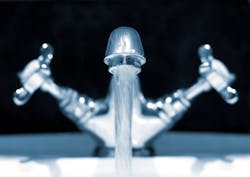Certification Action Line: Questions about pretreatment
Certification Action Line features questions and answers typical of those appearing in Water Quality Association (WQA) certification examinations. Some answers may not satisfy everyone or every condition.
1. True or False: An activated carbon filter that removes chlorine may not effectively remove chloramines or trihalomethanes.
2. Activated carbon may also be used to pretreat for organic substances. Which best describes the need for this pretreatment?
a. Prevents co-precipitation of volatile organic substances with hardness ions onto the membrane.
b. Reduces the likelihood of dissolved salts fouling the membrane.
c. Reduces the likelihood of low molecular weight organic substances passing through the membrane.
d. Reduces the likelihood of slightly hydrophilic substances passing through the membrane.
3. True or False: When water contains hardness, an ion exchange softener before a reverse osmosis (RO) system helps produce higher quality water with lower total dissolved solids (TDS).
4. True or False: Single-stage RO and ultrafiltration require no prefiltration of the feedwater supply.
5. The water hardness entering an RO system should be maintained at less than _______.
a. 1 grain per gallon
b. 3 grains per gallon
c. 5 grains per gallon
d. 12 grains per gallon
6. Protect polyamide RO membranes from the carryover of cationic polymeric coagulant by pretreatment with a _______.
a. Media filter
b. Cartridge filter
c. Manganese greensand filter
d. Water softener
e. Activated carbon filter
7. True or False: Ozone pretreatment breaks down organic substances that a carbon filter may not, and the ozone residual will not react with the membrane.
8. Which may be an alternative to ion exchange softening pretreatment to reduce hardness?
a. Electrodionization (EDI)
b. Nanofiltration
c. Oxidizing filter
d. Ultrafiltration
9. What is the typical rating on the guard filter before an RO pump?
a. 1 micrometer (µm)
b. 5 µm
c. 10 µm
d. 15 µm
10. Which signals potential pretreatment equipment problems?
a. Sudden rise in trend line monitoring
b. Unintended increase in the feedwater flow rate
c. Reduced pressure at the membrane surface
d. Decreased pH of the permeate
Answers
1. True. Some activated carbon filters have insufficient contact time to remove anything but chlorine taste and odor. Activated carbon can remove chlorine in seconds. Organic reduction and chloramine reduction may require 5 to 30 minutes of empty bed contact time, requiring additional bed depth/second carbon tank in series.
2. c. RO membranes often cannot reject low molecular weight organic substances. Pretreating with an activated carbon filter helps remove these substances. Slightly hydrophilic substances may also move through the membrane. However, their nature makes them difficult to remove with activated carbon.
3. False. Hard water pretreatment will not substantially increase the quality produced by the RO system. Softening helps reduce the precipitation of calcium carbonate, lessening membrane fouling and increasing its useful life.
4. False. The cleaner the water, the longer the membrane life.
5. b. High-hardness (more than 3 grains per gallon) water should be softened before entering an RO system.
6. d. The cation-exchange water softener attracts residual coagulant that might break through the sediment filter. The water softener should be downstream of the sediment filter and upstream of the RO system.
7. False. While ozone can oxidize hydrophilic organic substances, it is a significantly stronger oxidizer than chlorine and can easily damage an RO membrane, which is an organic polymer.
8. b. Nanofiltration rejects divalent salts and could reduce the hardness concentration. However, nanofiltration has some of the same drawbacks as RO. EDI is sensitive to buildup. In commercial/industrial situations in particular, it does not offer an economical solution as pretreatment, but is often used after RO for polishing.
9. b. Typically, a 5-µm filter helps protect equipment from problems with the pretreatment.
10. a. Commercial/industrial RO systems are monitored regularly for permeate quality. The results are charted to produce a trend line that often rises gradually. Unusual changes often indicate that the equipment cannot provide the required feedwater quality.
